The Nexus 7 (2013) Review
by Anand Lal Shimpi on August 22, 2013 6:00 PM ESTCPU Performance
The while the original Nexus 7 was fast for the money, the new Nexus 7 is just fast. Moving away from NVIDIA to Qualcomm, ASUS and Google settled on the APQ8064 Pro. Although we originally assumed this would be a quad-core Krait 200 based SoC, Brian's teardown revealed the part number 8064-1AA. What's special about that part number is it implies newer Krait 300 cores, making the SoC effectively a Snapdragon 600.
The CPU cores can run at up to 1.5GHz, putting it a bit lower than what we've seen from Snapdragon 600 based phones (e.g. HTC One tops out at 1.7GHz, while the US SGS4 hits 1.9GHz).
I was curious as to the impact of the lower frequency when combined with the potentially higher chassis TDP so I compared the Nexus 7 to the US Galaxy S 4. I turned to Geekbench because it offers a nicely woven mixture of single and multithreaded benchmarks, letting me look at peak available single core performance as well as what happens when multiple cores are active and working.
In this first graph we're looking at the first Krait 300 core running the workload. I've zoomed in to a small portion of the benchmark so we can get a better idea of CPU behavior:
The Nexus 7's CPU0 is almost always pegged at 1.5GHz whereas we see a lot of bursty thermal management on the smaller SGS4. This isn't unexpected, but what ends up happening is the sustained performance advantage drops from a peak theoretical max of 26% down to a more reasonable average gain of ~8%.
I was curious to see if multithreaded workloads showed any different behavior. Here we're looking at the fourth CPU core (CPU3). Note that it's not always active, which is why you see parts of the graph drop down to 0KHz. Once again we see similarly static behavior from the Nexus 7. Even with all four cores active, when you need the performance the Nexus 7 delivers a full 1.5GHz. These tests are short enough where we don't see tremendous swings in frequency, but once again we do see some frequency modulation in a smaller chassis.
The end result is that the Nexus 7's 1.5GHz Krait 300 cores are slower than what you'd get in a Galaxy S 4, however the gap isn't nearly as large as you'd expect it to be thanks to the larger chassis and how the platform is tuned. The Nexus 7 can run at 1.5GHz more consistently than Snapdragon 600 based phones can run at 1.7/1.9GHz.
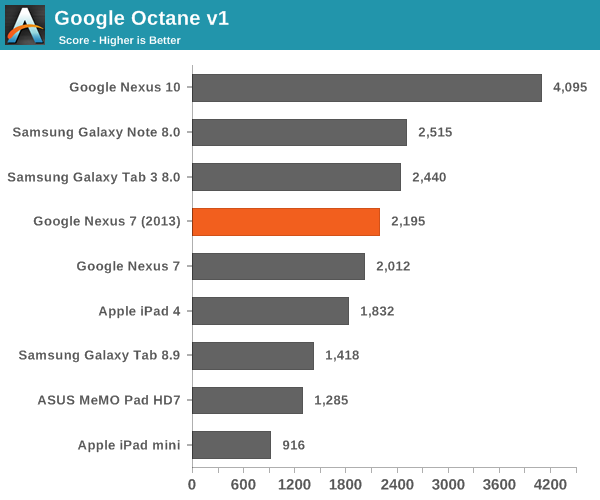


The GPU
Qualcomm seems to be frequency binning here, which is standard industry practice. Using binning to create these different SKUs gives Qualcomm pricing flexibility and also gives it the option to give large customers special treatment.
On the graphics side Qualcomm's Adreno 320 GPU makes an appearance. Clock speeds are also limited to 400MHz, compared to 450MHz for the high-end Snapdragon 600 implementations we've seen.
The APQ8064-1AA's dual-channel memory controller is populated with four x 16-bit DDR3L-1600 memory devices, giving the Nexus 7 a healthy amount of memory bandwidth. Peak memory bandwidth available to the APQ8064-1AA is 12.8GB/s, equalling what's available to Apple's A5X in the 3rd generation iPad with Retina display. Tons of memory bandwidth is obviously a pre-requisite for driving a high resolution display, and the combination of DDR3L-1600 and the Adreno 320 GPU delivers a butter smooth UI in all well written Android apps.
Although CPU performance is somewhat middle of the road compared to the rest of the landscape, GPU performance is faster than any other Nexus device on the market - and pretty much faster than any other similarly sized tablet:
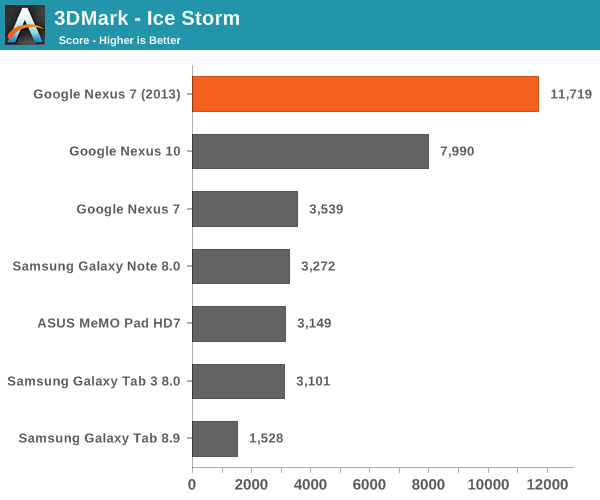
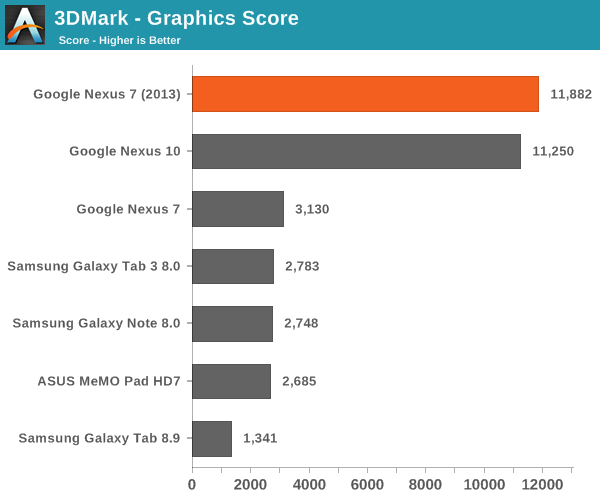
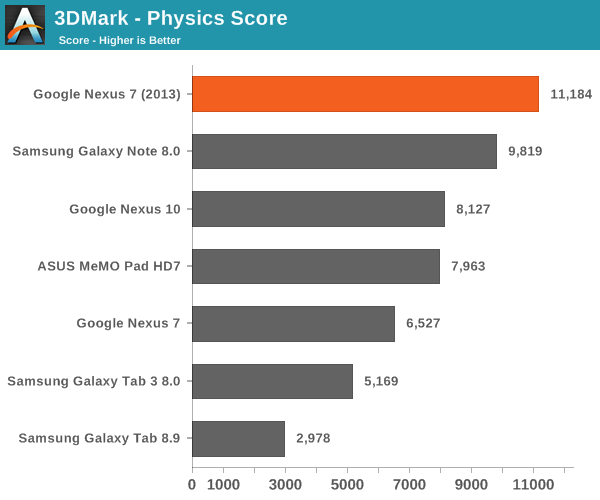
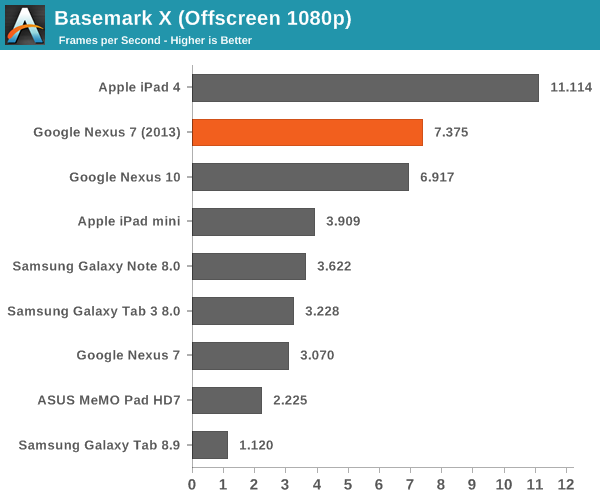
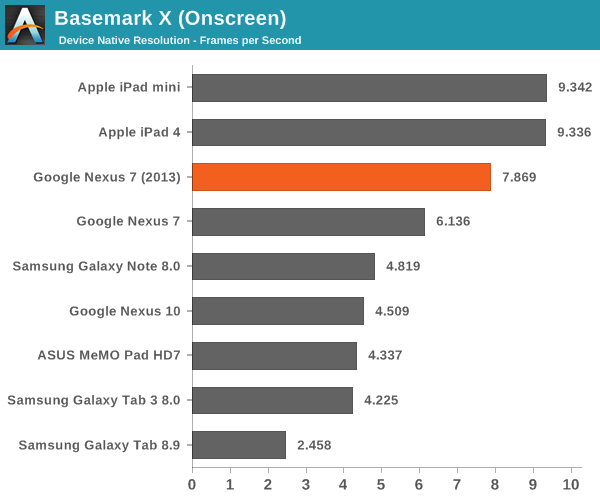
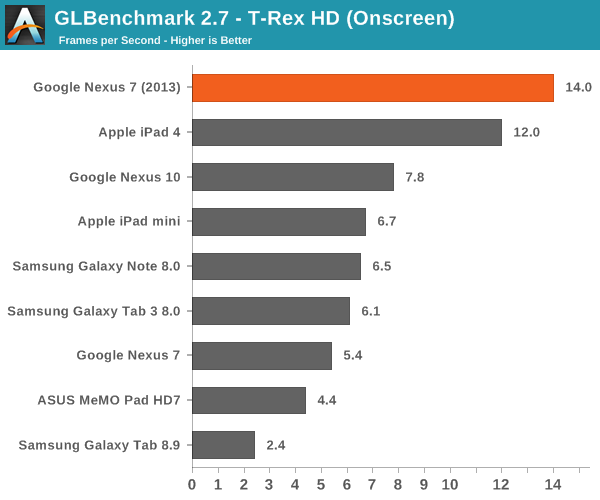
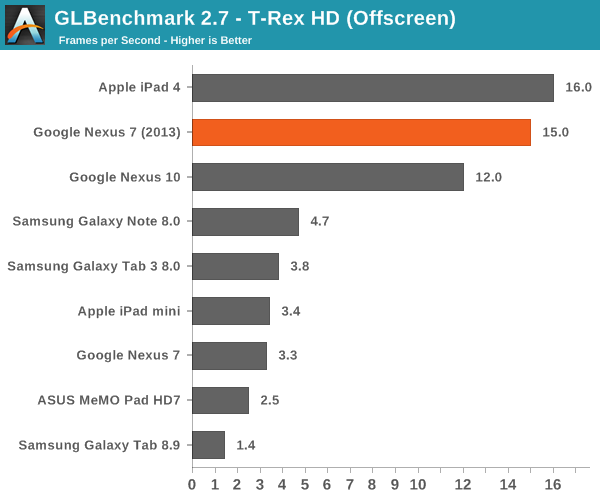
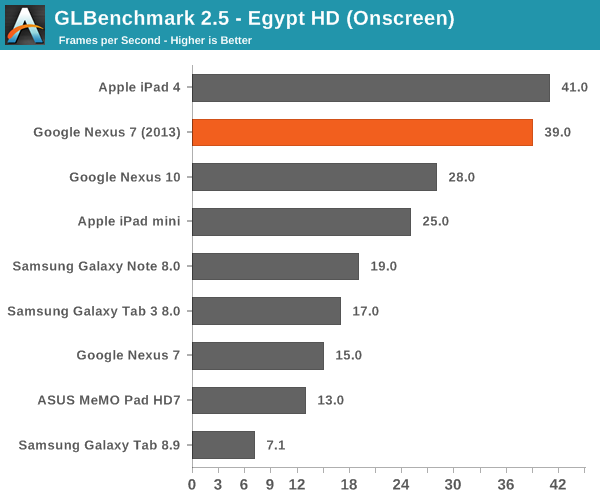
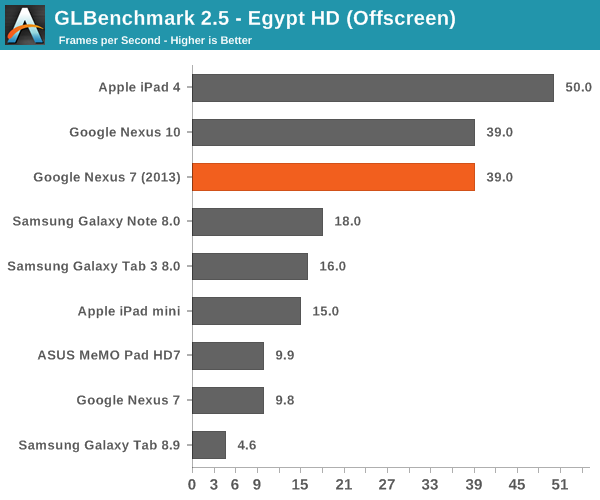
I played Modern Combat 4 as well as Shadowgun, both demanding 3D titles, on the new Nexus 7. Both titles appeared to render at the Nexus 7's native 1920 x 1200 resolution, and both appeared to do so at around 30 fps.


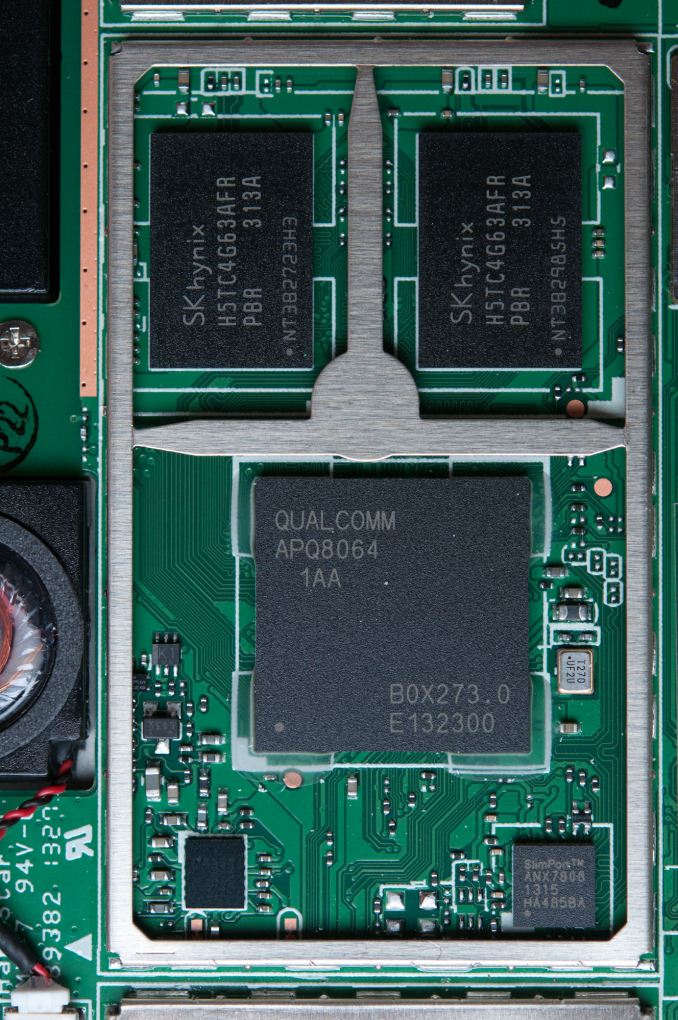
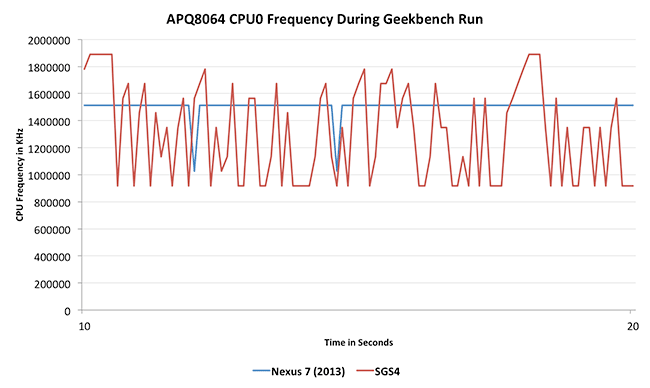
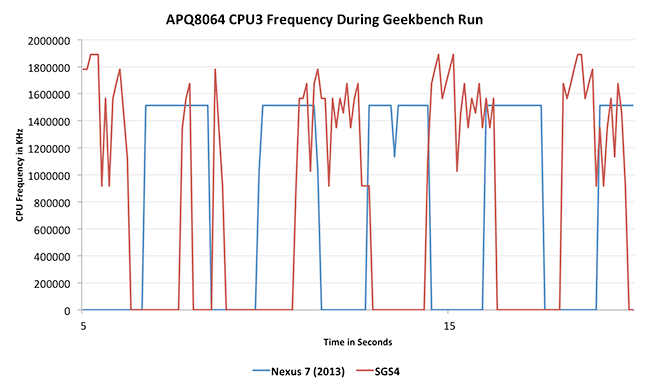








202 Comments
View All Comments
vailr - Friday, August 23, 2013 - link
Won't Amazon be updating their Kindle Fire lineup pretty soon? Although not ideal: the 8.9" Kindle Fire could be improved by addition of an SD card slot, and an easier option of rooting and installing the stock Android 4.3 O.S. (not too likely, I'd guess).Impulses - Friday, August 23, 2013 - link
Not too likely at all, on either count.Conficio - Friday, August 23, 2013 - link
Anand, have you ever run comparison tests between 200, 300, 400, 500 nits display? It would be nice to get an idea as to what battery life one can expect if the display is used outdoor, where you need the brighter display. Just one or two tablets/phones would be fine to get an idea. The Nexus 7 '13 seems to be a good candidate with its high max brightness.ASEdouardD - Saturday, August 24, 2013 - link
You can check out Engadget's review for something similar to this. They use brightness fixed at at 65 % (if I remember correctly) which is much higher than 200 nits on the new Nexus 7. If you have to use one test, Anandtech definitely has the best one, but Engadget's one does give you an idea of the impact of cranking up the brightness on the N7. Bottom line, battery life does take a hit, but it's still ok.iamkyle - Friday, August 23, 2013 - link
I don't see how this product can be called "the best" especially when Google/Asus has essentially railroaded purchasers of the 2012 Nexus 7. "Oh hey, I know we sold you this tablet, but check this one out! It's the same, but better!".Customer says "then why did you sell me this one in the first place?"
This endless praise of anything with a Google name on it reeks of bias.
turkeystyle - Friday, August 23, 2013 - link
For real! Nissan did the same thing to me when I bought an Altima a couple of years back. The next year's model was better but for the same price! And good god, my Galaxy S3 is barely a year old and what does Samsung do? Release the S4! The nerve! And don't even get me started on Nvdia and AMD and how they keep making better graphics cards every year.My buddy did the smart thing and bought an iPhone 5 last year. He's got at least another year before Apple releases an upgrade. So lucky to have the latest and greatest technology for that long!
But yeah, Google is definitely the worst. They just try to hide it by giving away web services.
meloz - Friday, August 23, 2013 - link
>Customer says "then why did you sell me this one in the first place?"While we wonder why you _bought_ it in the first place.
Thinly disguised Appletroll, you must do a better job.
ASEdouardD - Saturday, August 24, 2013 - link
You can't be for real. They didn't offer this product last year because available components and the prices of those components change every year. Prices go down, technology gets better. Google/Asus couldn't have offered a tablet like this at this price last year. Just plain impossible.Davidjan - Friday, August 23, 2013 - link
I had Nexus 7 I. I will buy Nexus 7 II. It is really convenient to extend its storage with : http://goo.gl/U6IyYImpulses - Saturday, August 24, 2013 - link
I ordered two of those... Not sure how much I'll really use it tho, might keep one on my keychain along with my regular USB micro reader and see how often I have the opportunity to use it, but for traveling and transferring loads of content from a PC (i.e. movies) I'd rather use a regular USB OTG adapter and a much faster USB 3.0 drive... It's going into my travel bag until I'm sitting down on a plane/train/hotel either way.